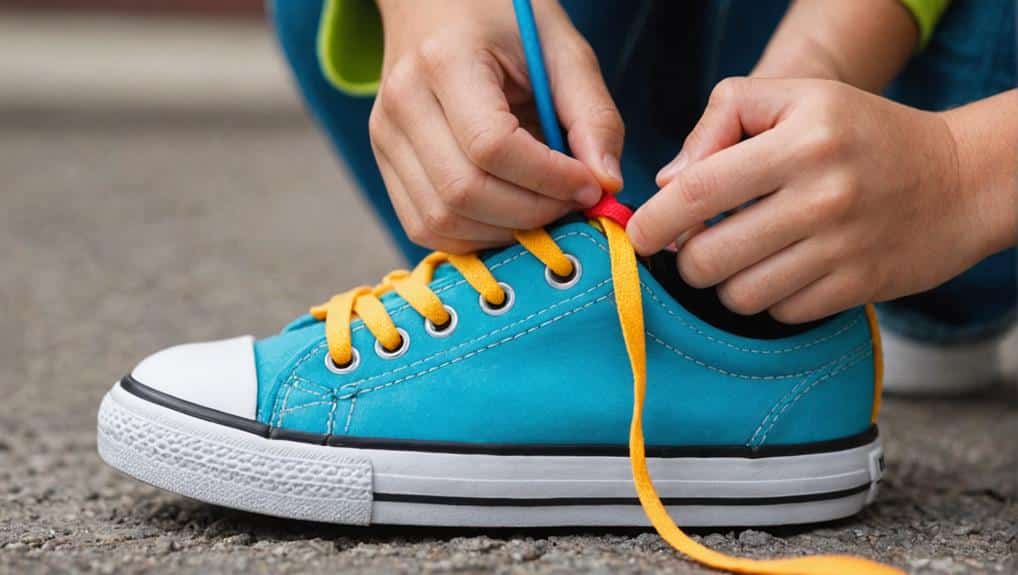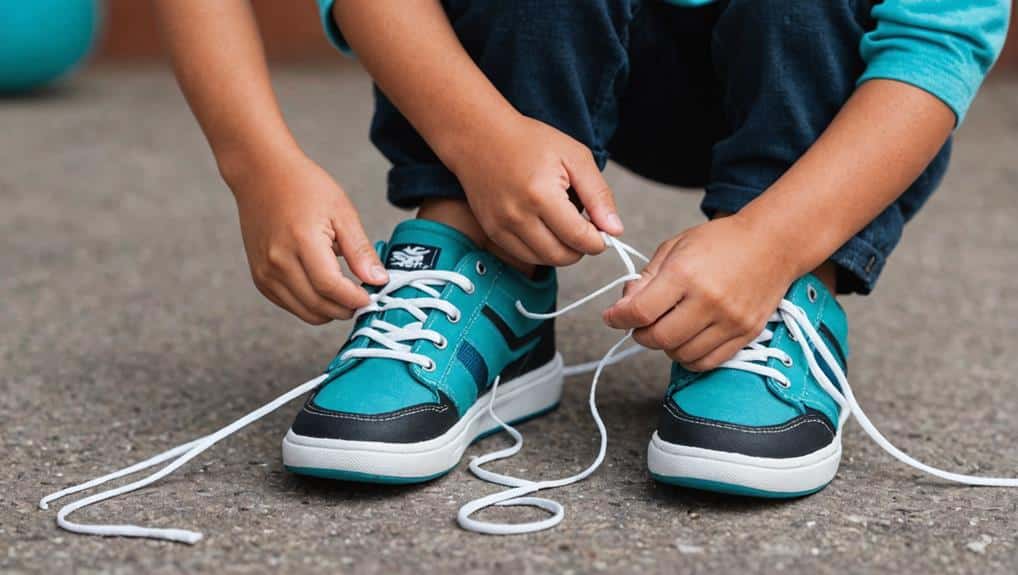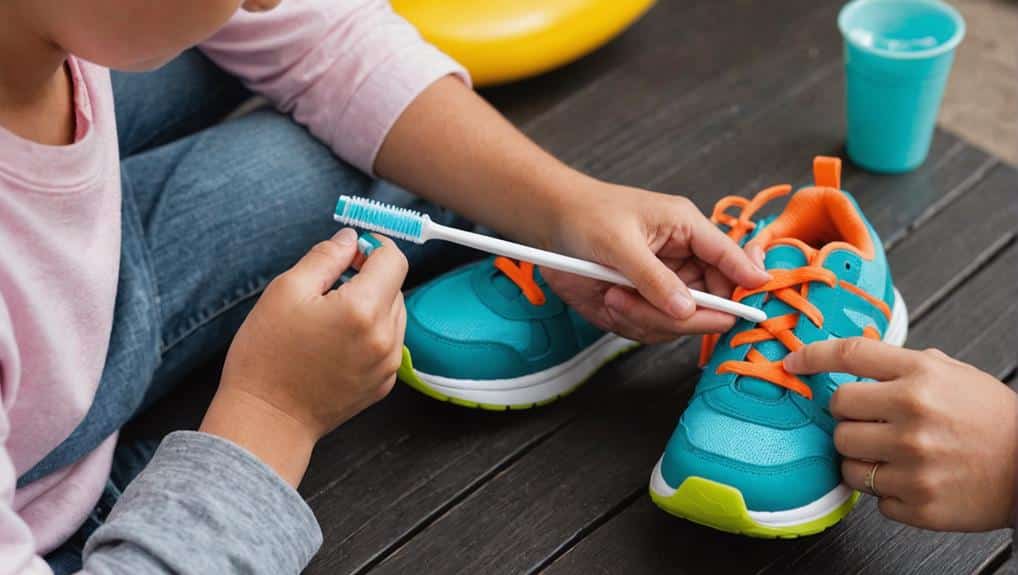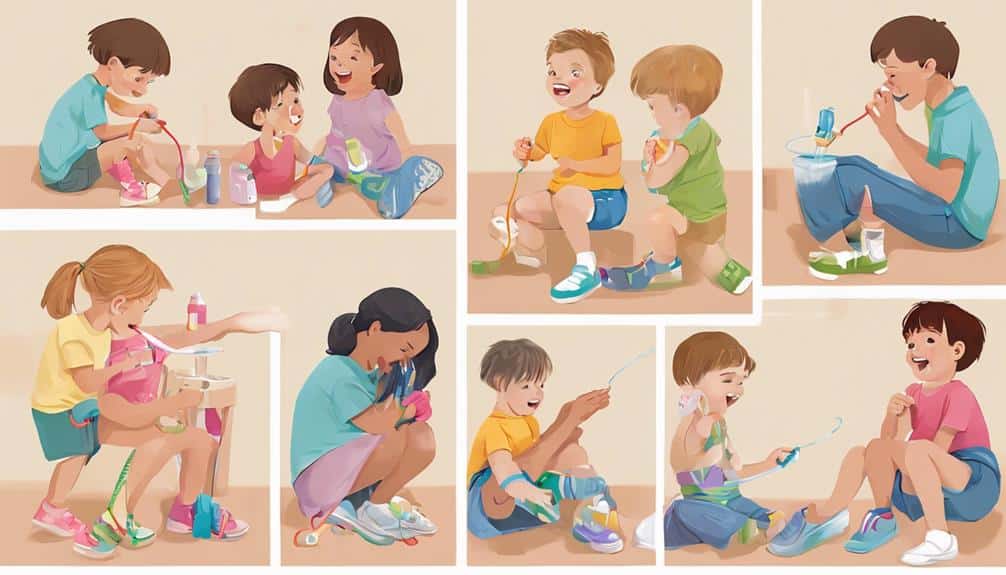Key Takeaways
- Toothbrushing and shoe tying are essential ADLs children typically master by age 10, indicating skill and independence.
- Shoe-tying readiness usually occurs around age 5, indicating manual dexterity suitable for toothbrushing.
- Structured, step-by-step teaching techniques, including tying boards and visual aids, are effective for teaching these skills.
- Adaptive techniques, such as stretchy shoelaces or the ‘loop and swoop’ method, can help children with special needs master shoe tying.
- Challenges in learning these ADLs might be due to developmental disorders like Autism or ADHD and can be addressed by breaking down the processes into manageable steps.
Establishing Toothbrushing Habits
Establishing solid toothbrushing habits during childhood is fundamental to promoting lifelong oral health. A critical developmental milestone linked with this is a child’s ability to tie shoes independently. This is a simple yet effective indicator of a child’s manual dexterity and readiness to brush their teeth without supervision.
Pediatric occupational therapists often use such milestones to gauge a child’s readiness for specific ADL skills. These self-care abilities, such as toothbrushing, are essential for a child’s development and independence. Children, by nature, are keen to assert their independence and may insist they can handle toothbrushing alone. However, adults must supervise this process until a child demonstrates the necessary talent.
The tie-shoes milestone is a helpful gauge; if a child can adeptly handle the intricate loops of shoelaces, they likely possess the coordination needed for effective tooth brushing. Doctors and oral health experts underscore the significant importance of early dental health. They advise that parents and caregivers remain engaged during toothbrushing sessions, providing guidance and feedback. The tie-shoes rule ensures that children are physically capable of performing a thorough cleaning. Remember, instilling good toothbrushing habits is not just about the act itself but about fostering a broader understanding of health and self-care.
Improving Brushing Techniques
While mastering the skill of toothbrushing alone is a significant achievement for a child, it is essential to focus on refining the technique. The development of fine motor skills plays a crucial role in this process. Children should not brush alone until they can tie their shoes, as a lack of talent can affect proper tooth cleaning. Occupational therapists often emphasize this correlation.
Children often want to brush their teeth, but supervision is vital for effective cleaning. Engaging with kids during brushing can make the activity more enjoyable and effective in maintaining good oral hygiene. Adults should work diligently to transform this daily routine into a fun and educational activity.
The initial struggle with tooth brushing is common for kids, highlighting the importance of adult supervision. The doctor’s tip to supervise kids’ brushing to guarantee thorough cleaning and prevent dental issues is invaluable advice.
| Age | Supervision Level | Brushing Technique |
|---|---|---|
| Under 3 | High | Adult-guided |
| 3-6 | Moderate | Adult-supervised |
| 6-10 | Low | Independent with checks |
Through practice and patience, children can master effective brushing techniques, setting themselves up for lifelong oral health.
Understanding Shoe Tying Readiness

Are your children prepared to tackle the task of shoe tying? Recognizing shoe-tying readiness is a vital step in your child’s development. Typically, the milestone of shoe-tying readiness occurs around the age of 5. However, each child is distinct; some may need assistance up to 9.
A key indicator of shoe-tying readiness is the mastery of bilateral tasks. Bilateral tasks involve fine motor skills, like cutting shapes and buttoning clothes. Children must demonstrate proficiency in these bilateral tasks before starting shoe-tying training.
Children learn at their own pace, which is essential to ensure they are developmentally prepared for the shoe trial. This readiness indicates not only their cognitive growth but also their motor development and social skills growth. Children ready for this task will show the necessary coordination and focus, which signifies a significant step in their motor skill development.
Setting children up for success involves more than just teaching the task. It requires an understanding of their readiness level. Patience and attentiveness to these details will guarantee your child a positive and successful learning experience.
Methods for Teaching Shoe Tying
Adopting a structured step-by-step approach can be highly advantageous in teaching your child how to tie their shoes. Start with a tying board, then progress to a shoe on a table. This gradual process helps children grasp the procedure without the added difficulty of reaching their own feet. Occupational therapists often recommend children practice on a parent’s shoe initially, as its larger size can make it simpler. This practice aligns with the principles of Pediatric Therapy, which often integrates task analysis and positive reinforcement for effective skill building.
Mastering each step before moving on is a vital part of the process. This strategy, in line with proven pediatric therapy methods, helps reduce frustration and build confidence, making the learning experience more enjoyable for your child. Different methods like the traditional cross and pull, the two bunny ears, or the double-crossing should be investigated gradually, but avoid discussing them in detail at this stage.
Finding the best method for each child is crucial to guarantee successful learning. Some children might find one method more straightforward than the others. Consider their preferences and capabilities when teaching them how to tie their shoes. Please encourage them to practice regularly, as repetition is vital to mastering this fundamental life skill.
Exploring Shoe Tying Techniques
Having established a foundational understanding of shoe-tying instruction methods, we shall explore specific techniques in more detail. Tying shoes is a significant self-care activity that fosters independence, fine motor skills, and overall development in children’s self-care activities. It is a complex task that demands a certain level of motor skills, cognitive abilities, and significance. Incorporating this task into daily routines can improve children’s functional abilities, autonomy, and life skills.
Here are five methods that have proven effective:
- *The Bunny Ears Method*: This technique involves creating two loops (or “bunny ears”) and tying them together.
- *The One Loop Method*: This technique requires making one loop, wrapping the other lace around it, and pulling it through.
- *The Magic Fingers Method*: This method teaches children to use their fingers in a specific way to create loops and execute a knot.
- *The Circle Method*: Children learn to tie by making circles with the laces.
- *The Cheerio Method*: This method uses a small ring or “cheerio” to help guide the laces into a knot.
Modifications for One-Handed Shoe Tying
In mastering the critical Activity of Daily Living (ADL) of shoe tying, children with one-handed talent may need to adopt adaptive lacing techniques. This process can be seen as a self-care activity that promotes independence and nurtures mental health. Additionally, participating in such activities helps them cultivate resilience and problem-solving skills. These can be acquired through different sources, such as instructional videos on online platforms like YouTube. Moreover, tailored support from occupational therapists can significantly improve the learning process and guarantee a successful result.
Adaptive Lacing Techniques
Mastering the craft of shoestring knotting with one hand is an essential adaptive life skill for individuals with physical limitations and an impressive accomplishment of autonomy. It offers a feeling of self-sufficiency, a fundamental element for comprehensive development. Adapting to traditionally tying shoes with one hand may seem demanding. However, this skill can be perfected with practice and the appropriate methods.
Several adjustments can be implemented to traditional lacing methods to suit individuals with one hand:
- Stretchy shoelaces can be tailored to fit securely around the foot without needing a knot.
- The embrace of a ‘loop and swoop’ technique, specifically tailored for individuals with one hand.
- Exploration of various lacing patterns, such as diagonal or ladder lacing, to discover the most effective method for one-handed typing.
- The use of adaptive tools, such as shoe-tying assists, to aid in the process.
- Scheduling sessions with Occupational therapists who can offer customized solutions for adjusting lacing methods.
These adaptive methods provide the resources necessary for individuals with one hand to conquer the obstacle of shoestring knotting, enhancing their self-assurance and autonomy.
Instructional Video Resources
Many instructional video resources showcase adjustments for one-handed shoe tying based on adaptive lacing techniques. Platforms like YouTube are a goldmine of visual aids, offering step-by-step guidance to individuals with limited dexterity, enabling them to excel in tying their shoes independently.
These instructional video resources utilize various lacing methods and adaptations tailored to address the distinct challenges encountered in one-handed shoe tying. From alternative looping strategies to inventive knotting techniques, these videos offer a diverse learning experience accessible at the viewer’s convenience. They serve as a valuable tool to build confidence and foster self-reliance in children mastering this crucial life skill.
Moreover, these resources are advantageous for individuals needing to acquire these techniques and for caregivers, parents, and educators committed to assisting others. Exploring these extra resources can provide them with different strategies to aid their charges in overcoming any obstacles they may encounter while tying their shoes. Remember, every child’s path to mastering these fundamental skills is unique, and these resources offer a route to tailored efficient solutions.
Pediatric Occupational Therapy Solutions
Many pediatric occupational therapy solutions exist to assist children in mastering the art of one-handed shoe tying. These solutions cater to the distinct needs of one-handed individuals, providing them with the necessary skills and confidence to perform this daily task independently.
Occupational therapists are trained to adapt their teaching methods to suit specific children’s abilities and preferences. They can provide tailored solutions and strategies that make shoe tying more accessible and manageable. These solutions may include but are not limited to:
- Alternative lacing techniques to simplify manipulation.
- Access to instructional videos on platforms like YouTube for visual guidance.
- Tailored solutions and strategies customized to one-handed individuals’ particular needs.
- Exploration of diverse resources and techniques directed at one-handed shoe tying.
- Adaptation of teaching methods to suit each child’s abilities and preferences.
Addressing Shoe Tying Struggles

In addressing shoe-tying struggles, it is crucial to initially identify the potential causes that may impede a child’s ability to master this skill. Conditions such as Autism Spectrum Disorder, ADHD, or general executive dysfunction can affect the focus, planning, and coordination needed. It is important to consider teaching techniques that break down the shoe-tying process into manageable steps, offering a more accessible learning path for children facing challenges.
Understanding Tying Difficulties
While most children can perfect shoe things by six or the end of their initial grade, some may struggle for different reasons. Understanding these difficulties is essential in guiding children towards mastering this pivotal skill.
Various factors contribute to such struggles, including:
- Developmental disorders can interfere with coordination, making the complex motions of shoe-tying challenging.
- Executive dysfunction: This condition can hinder focus, planning, and coordination, which are critical for shoe tying.
- Autism Spectrum Disorder: This condition can affect a child’s sensory processing and motor skills, complicating shoe-tying.
- ADHD: Children with this disorder may struggle with focus, making it hard for them to learn and remember the steps of shoe tying.
- Process complexity: The multi-step process of shoe tying can overwhelm some children, necessitating a breakdown into more straightforward, manageable steps.
Effective Teaching Techniques
Addressing shoe-tying challenges in children necessitates implementing effective teaching strategies. Break the process into manageable steps, focusing on mastering one skill at a time. Positive reinforcement during each stage plays a critical role in encouraging children to persist in their learning adventures.
Introducing alternatives, like the bunny ears approach, can make the task more engaging and accessible. This technique involves creating two loops (or “bunny ears”) with the laces and tying them together. It simplifies the standard method and is often easier for children to grasp.
Consistency and patience are key in the learning process. To enhance the child’s confidence and motivation, encourage regular practice of tying shoes and celebrating small accomplishments.
Here’s a summarized approach:
| Step | Technique | Reinforcement |
|---|---|---|
| 1 | Breakdown the process | Positive feedback on mastering each step |
| 2 | Use alternatives like the bunny ears approach | Celebrates creativity and adaptability |
| 3 | Encourage consistent practice | Celebrates small accomplishments |
Through these techniques, children can gradually overcome shoe-tying challenges, developing a fundamental life skill while growing in confidence and resilience.
Practical Tips for Shoe Tying
Mastering the art of shoe tying is a significant milestone typically achieved by most children by the age of 6 or the end of the initial grade. However, developmental disorders or executive dysfunction can sometimes hinder acquiring this crucial skill. Here are five practical tips to facilitate the shoe-tying learning process:
- Start with the basics: Ensure the child has the necessary skills for shoe tying, such as manual dexterity and bilateral coordination.
- Use alternative methods: The bunny ears technique could prove more straightforward for children struggling with traditional shoe tying.
- Be patient and consistent: Learning to tie shoes can be slow for some children. Persistence and patience are key.
- Regular practice can help solidify the skill, turning it from a conscious effort to an automatic action.
- Positive reinforcement: Celebrate every success, no matter how small, to enhance the child’s motivation and confidence.
Alternatives to Traditional Laces

While traditional shoelaces are standard, they may pose challenges for children still mastering fine motor skills. Alternatives to conventional laces, such as U-Lace no-tie shoelaces, provide a convenient and stylish option for easy shoe-wearing. By exploring the benefits of these lace alternatives, the different lace-free shoe options available, and the unique opportunity for customizing with no-tie laces, parents can help their children become more independent in dressing.
Benefits of Lace Alternatives
In the world of footwear, there’s a significant shift from conventional shoelaces to more imaginative and user-friendly alternatives such as U-Lace and no-tie shoelaces. These inventive laces are practical and ignite creativity and uniqueness among users. They are particularly beneficial for kids who find learning to tie shoelaces challenging, allowing them to easily slip on their shoes and confidently go about their day.
Consider the following benefits of U-Lace laces:
- *Ease of use*: U-Lace laces are designed for all sneaker types, providing a no-tie, user-friendly solution, especially for kids.
- *Customization*: U-Lace offers a variety of mix-and-match options in numerous colors to suit unique styles.
- *Fashionable*: Apart from being functional, these laces are stylish and can complement any outfit.
- *Confidence enhancer*: By age 10, kids may feel embarrassed if they still struggle with traditional laces. U-Laces can help boost their confidence.
- *Time saver*: U-Lace laces save time and eliminate the need for re-tying, allowing kids to focus more on their activities and less on their footwear.
In a year, the traditional ‘Kids to Tie’ becomes a thing of the past, thanks to U-Lace no-tie shoelaces.
Lace-Free Shoe Options
Beyond traditional shoelaces, various lace-free shoe choices have emerged to offer children comfort and style. One such answer is U-Lace no-tie shoelaces, providing a brilliant mix of fashion and functionality for children’s slip-on sneakers. With their vibrant colors and playful designs, these laces not only elevate the visual appeal of the shoes but also allow for distinct customization possibilities.
A noticeable similarity to conventional woven laces sets U-Lace apart but with the additional advantage of the convenience associated with slip-on shoes. The design is versatile, suitable for all sneaker types, and in many colors to cater to each child’s style.
Moreover, the U-Lace Kiddos collection is specifically crafted to elevate children’s confidence and self-expression, offering mix-and-match options for various looks. In the world of lace-free shoe choices, this groundbreaking no-tie solution sets a new standard, combining practicality with customization to meet the footwear needs of children under 10.
Personalizing With No-Tie Laces
Shifting our focus from the broader range of lace-free shoe choices, we now highlight U-Lace no-tie shoelaces as a creative substitute for traditional laces. These inventive laces help simplify tying shoes for children and add a fashionable touch to any sneaker.
U-Lace laces are crafted to resemble conventional woven shoelaces, yet they eliminate the need for tying, making them a convenient option for children mastering this essential ADL. Moreover, they are available in various vibrant, trendy colors and styles, allowing children to personalize their footwear.
Here are some noteworthy aspects of U-Lace no-tie laces:
- They streamline the process of wearing shoes by removing the requirement for tying.
- U-Lace offers a range of lively colors and styles.
- They mimic woven shoelaces for a classic appearance.
- U-lace laces provide distinct customization options for a personalized touch.
- They are suitable for all kinds of sneakers, providing functionality and style.
Fostering Confidence With U-Lace Kicks
Have you ever pondered the role of footwear in nurturing a child’s self-assurance? A pivotal element of this growth often disregarded is shoe lacing. U-Lace no-tie shoelaces offer a distinct approach to this task, enhancing a child’s self-esteem through self-expression and autonomy.
U-Lace Kicks come in various vibrant, stylish colors resembling traditional woven shoelaces, providing children with a familiar and cozy shift. The laces offer personalization options suitable for all sneaker types, allowing children to showcase their style, which in turn helps to enhance their self-assurance.
The U-Lace Kiddos collection involves children more in the shoe-lacing process. With varied personalization options, children can mix and match diverse colors, creating an enjoyable and immersive activity that simultaneously develops their motor skills.
Integrating U-Lace Kicks into a child’s routine streamlines the shoe-lacing process and nurtures a sense of achievement and self-confidence. This confidence uplift can positively impact other areas of their lives, showing that mastering this seemingly straightforward ADL profoundly affects a child’s overall growth.
Frequently Asked Questions
Should a 10-Year-Old Be Able to Tie Their Shoes?
Yes, a 10-year-old should typically be able to tie their shoes, having mastered appropriate shoe-tying techniques. However, respecting personal developmental timelines and considering shoelace alternatives if necessary is crucial.
How to Teach a 10-Year-Old to Tie Shoes?
To teach a 10-year-old to tie shoes, implement easy techniques like the bunny ears method. Use shoe-tying aids for practice. Break the process into small steps and provide positive reinforcement for progress.
When Should a Child Learn to Tie Shoelaces?
Typically, children should reach the shoe-tying milestone between ages 4 and 8. However, mastering shoelace challenges varies, contingent upon a child’s development and readiness for this bilateral task. Some may require guidance until age 9.
What Are the Developmental Milestones for Tying Shoes?
Developmental milestones for tying shoes typically involve mastering bilateral tasks, such as cutting and buttoning, by age 5. Proficiency in lacing, a precursor to shoe tying, and overcoming shoe-tying challenges are also critical readiness indicators.
Conclusion
To sum up, mastering these basic Activities of Daily Living (ADLs) promotes independence, enhances self-assurance, and prepares children for more advanced tasks. Finding their way through the maze of toothbrushing techniques and shoe-tying methods may appear challenging. However, with adaptive strategies, alternatives like U-Lace Kicks, and consistent practice, children will undoubtedly overcome these crucial life skills. The victorious moment when children brush their toothbrushes and shoes untied is proof of their increasing autonomy and a foundation for their growth.


Recent Comments